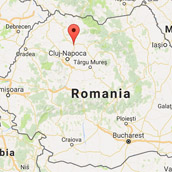Historical Background
 Salt-mining town in northwestern Romania, on the Someş River 60 km northeast of Cluj. The first documented reference to Dej (Ger, Desch; Hun., Dés) dates to 1061. After legislation in 1693–1700 had prohibited Jews from settling in mining towns, authorities in Dej decided in 1722 to forbid Jewish residence. No Jews lived there until 1834; and just three were mentioned in 1838.
Salt-mining town in northwestern Romania, on the Someş River 60 km northeast of Cluj. The first documented reference to Dej (Ger, Desch; Hun., Dés) dates to 1061. After legislation in 1693–1700 had prohibited Jews from settling in mining towns, authorities in Dej decided in 1722 to forbid Jewish residence. No Jews lived there until 1834; and just three were mentioned in 1838.
When exclusions were gradually lifted after 1850, the Jewish population of Dej increased. In 1857 there were 122 Jews, a number that rose in 1869–1870 to 351; in 1890 to 1,114; in 1930 to 3,360 (representing 22.2% of the town’s population); and in 1941 to 3,719 (22.8%). The statutes of the Jewish community were adopted in 1862, when Menaḥem Mendel Paneth (1862–1885; son of the chief rabbi of Transylvania, Yeḥezkel Paneth) became the town’s first rabbi. He was succeeded by Mosheh Paneth (1886–1903), Yeḥezkel Paneth (1903–1929), and Ya‘akov Elimelekh Paneth (1930–1944). The first synagogue was founded in 1864, and a new one was built in 1909; the old synagogue was given to the town’s 250 Hasidic families. The burial society was set up in 1857, led by Nathan Friedländer (1819–1896), who was a physician, poet, and writer.
Dej’s Jewish elementary school opened in 1891 and functioned until 1944. Its first was established in 1862, and by 1940 there were 5 such institutions in the town, to which 14 heders and a Talmud Torah (1923) had also been added. After the schism of the Jewish Congress of Hungaryand Transylvania (1868–1869), the community of Dej chose to be Orthodox. A women’s association was formed in 1889. After World War I, the Zionist movement was strongly supported by youth organizations and numerous periodicals.
In the 1930s, Dej was home to 7 Jewish manufacturers, 161 artisans, 185 traders, 44 clerks, 33 employees of the Jewish community, 25 teachers, 12 lawyers, 11 physicians, 6 engineers, 5 pharmacists, 4 bankers, 44 retired persons, and 88 seasonal workers. A Jewish club with a library was opened in 1930. The writer Me’ir Yehudah Majerovits (1895–1944) and the artist Éva Lázár (1914–1944) were born in this town. In 1894, a Hebrew printing press was established; it ultimately printed 14 books.
After 1940, Dej was part of the northern Transylvania region transferred from Romania to Hungary. In May 1944, when Hungary was occupied by German troops, Jews of Dej were confined in ghettosand then deported to Auschwitz. In the forest of Bungur, near Dej, one of the 13 central ghettos of northern Transylvania was established, whence 7,674 Jews were deported on 28 May and 6–8 June 1944. The 239 Jews who survived reorganized the community in 1946, and in the following year the Jewish population had grown to approximately 1,000 members. As a consequence of emigration, there were only some 30 Jews living in Dej in 2003.
Suggested Reading
József Schweitzer and Kinga Frojimovics, eds., Magyarországi zsidó hitközségek: 1944, április; A Magyar Zsidók Központi Tanácsának összeírása a német hatóságok rendelkezése nyomán(Budapest, 1994), vol. 1, pt. B, pp. 172–173; Zoltán Singer, ed., Volt egyszer egy Dés: Bethlen, Magyar Lápos, Retteg, Nagyilonda és környéke, 2 vols. (Tel-Aviv, 1970); Péter Újvári, ed., Magyar zsidó lexikon (Budapest, 1929), p. 196.
Author
Translation
Translated from Romanian by Anca Mircea
From
Ladislau Gyémánt, "Dej." In: YIVO Encyclopedia of Jews in Eastern Europe.
New Haven: Yale University Press, 2008. Accessed December 5, 2016.
Reproduced by permission of Yale University Press.
 The YIVO Encyclopedia of
The YIVO Encyclopedia of